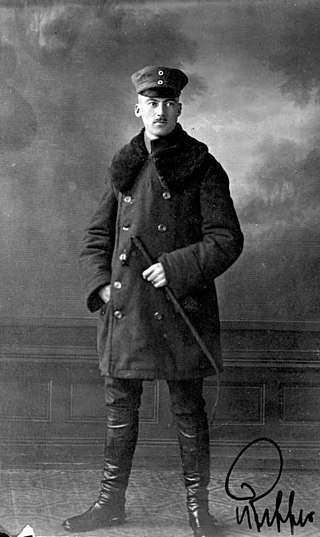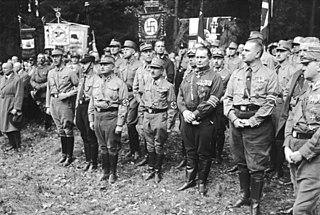Plot
The opening is a montage of Hitler's life from 1899 to 1913, when he left Austria for Munich. His participation in the First World War on the German side is then shown in a series of episodes that includes his promotion to the rank of corporal, his awarding of the Iron Cross for bravery and his blinding during a gas attack and his subsequent medical treatment, during which he learns Germany has surrendered.
Hitler returns to a revolutionary Munich in 1919 and, still employed by the army, is assigned to report on the newly formed political parties in the city. After attending a meeting of the German Workers' Party, he is recruited by the party's leader, Anton Drexler, to organize its propaganda activities and give increasingly popular speeches that harp on the themes that Germany has been betrayed by the leaders who surrendered in the last war and that Communists and Jews are sapping the German spirit from within. After meeting the wealthy art publisher Ernst Hanfstaengl, Hitler is encouraged to refine his image and create a symbol for the party, which he does by adopting the swastika. Hanfstaengl also puts Hitler in contact with the city's influential figures, including the war hero Hermann Göring, and the militant Ernst Röhm, eventual organizer of the paramilitary SA, who Hitler had met previously but was unable to afford him and his men. In 1921, Hitler forces Drexler to resign and takes over as leader of the renamed National Socialist Party.
In 1923, the Minister of Bavaria, Gustav von Kahr, urged on by his speechwriter, the journalist Fritz Gerlich, tries to outfox Hitler by convincing him that he is preparing to stage a military coup against the national government in Berlin and that Hitler must remain silent, or his party can play no part in it. Upon learning that the proposed putsch is merely a ruse, Hitler confronts Kahr at gunpoint and coerces him and his associates into supporting his own plan for a putsch. Röhm and the SA plan to take over the military barracks in preparation for a march on Berlin, but the attempted coup is quickly crushed. Hitler takes refuge at the Hanfstaengl home, almost resorting to suicide before Ernst's wife takes the gun from his hand.
Arrested by the authorities and tried for treason, Hitler manages to use the trial to his advantage, winning over the audience and the judge with his courtroom theatrics, with only Gerlich and the prosecutors unmoved by his speeches. Consequently he is awarded a lenient sentence in Landsberg Prison, where he writes his memoirs (later published as Mein Kampf ). In 1925, Hitler goes to the countryside to escape from politics and is joined by his older half-sister, Angela, and her daughter, Geli Raubal. When he returns to Munich, Hitler takes Geli with him.
Eschewing revolution, Hitler now demands that the party follow a democratic course to power. That declaration puts him into conflict with Röhm, but Hitler's demand for complete subordination of the party to himself as Führer (Leader) wins the approval of most others, including an impressionable young agitator named Joseph Goebbels. During the late 1920s, the party's political fortunes improve due to Hitler's speeches and the stock market crash ruining the economy, with the National Socialists gaining more and more seats in the Reichstag with each election. Alarmed by the party's growing popularity, Gerlich continues to write articles in opposition to Hitler and, when the paper's editor fires him, forms his own newspaper called The Straight Path.
Meanwhile, Hitler forms a relationship with Geli but eventually, distraught by his overbearing control on her life, she commits suicide, after which Hitler forms a relationship with Eva Braun.
In 1932, Hitler becomes a German citizen and runs for president against the incumbent, Paul von Hindenburg. Although he is unsuccessful, the party becomes the largest in the Reichstag shortly after, which emboldens Hitler to demand that he be made Chancellor of Germany. Though Hindenburg despises Hitler, the former Chancellor Franz von Papen helps bring that about in January 1933. Later, the Reichstag building is set on fire, allegedly by a communist, and Hitler uses the incident to have members of the Reichstag award him dictatorial powers, which include suspension of civil liberties such as freedom of the press. As a consequence, Gerlich's newspaper is shut down and he is arrested by the SA and sent to a concentration camp.
Germany now becomes a police state, and Hitler crushes all his opponents, both inside and outside the party, which sees Röhm being arrested and the SA greatly reduced. Röhm is later sentenced to death along with others like von Kahr and Gerlich, and the rest of the SA is absorbed into the Reichswehr army. After Hindenburg's death in August 1934, Hitler combines the office of president and chancellor into one, finally making him the ultimate ruler of Germany.
Reception
The miniseries received mixed reviews but was nominated for seven Emmy Awards and won two. [1] It received a nomination as "Outstanding Miniseries" and Peter O'Toole was nominated for an Emmy in the supporting actor in a TV movie or miniseries category. The miniseries won a Primetime Emmy Award for Art Direction and John Douglas Smith won the Emmy Award for "Outstanding Sound Editing For A Miniseries, Movie Or A Special" as Supervising Sound Editor. [1] [6]
The New York Times said: "The filmmakers worked so hard to be tasteful and responsible that they robbed their film of suspense, drama and passion", but commented positively on the performances of Peter O'Toole, Julianna Margulies, and Liev Schreiber. [7]
David Wiegand of the San Francisco Chronicle gave it a positive review, praising Carlyle's performance as "brilliant". [8]
The German magazine Der Spiegel called the film a "soap opera" and "flat melodrama with invented key scenes - Hitler for stupid people." [9]













